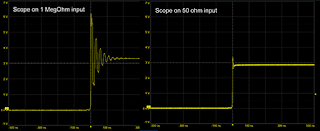Dr. Eric Bogatin
 |
| Figure
1. The same signal from a fast-buffer driver measured with a 1-meter, 50 ohm cable with 1 megaohm input to the scope, and same cable with 50 ohm input to the scope. |
For additional information on this topic, check out my webinar on What Every Oscilloscope User Needs to Know About Transmission Lines.
Use 1 MOhm when you use a 10x probe
The only setting to use with a 10x probe is the 1 MOhm input. You have no choice.
If the bandwidth of your signal is below about 200 MHz, the 10x probe is a great probe to use for all general-purpose applications. The downside of a 10x probe is that it reduces the signal-to-noise ratio by 20 dB because it attenuates the signal by 10x.
In a 12-bit resolution scope, the input peak-to-peak noise is about 1 mV. This corresponds to a tip voltage sensitivity of 10 mV/div as the most sensitive scale. If you wish to measure low-level signals that are less than about 100 mV, the 10x probe will limit your sensitivity. In this case, consider using a direct connection or an active probe.
Use 1 MOhm for low-level signals over a direct cable connection
If your application is for measuring very low-level signals, use a direct cable connection to the scope on a 1 MOhm input scale. Then you have the full sensitivity of the scope amplifier. On the 1 MOhm scale, you will be able to measure voltages as high as 50 V, with large dynamic range offset and AC coupling.
The downside of using a direct cable connection with the 1 megaohm input is that now you may introduce reflection artifacts, such as shown in Figure 1.
Reflections always happen when a signal encounters a change in the instantaneous impedance. If the rise time of the source is longer than about 4x the time delay of the cables, then the reflections will be smeared out during the rising or falling edges of the signal. The reflection artifact will be negligible.
In the case of a long-rise-time signal, or short cables, you should not have to worry about reflections, and using a 1 MOhm input impedance to the scope should be just fine. This will enable you to look at higher voltage signals, lower level signals, enable more DC offset and use AC coupling.
1 MOhm input is the preferred setting for long rise time or low bandwidth signals. How low a bandwidth? If the typical cable length is 1 meter, the time delay in a cable is about 5 nsec. This means for signal rise times longer than 4 x 5 nsec = 20 nsec, a 1 MOhm input is just fine. This is a bandwidth of a signal of about 0.35/20nsec = 17 MHz. If your signals have a bandwidth below 20 MHz, don't hesitate to use the 1 MOhm input.
Use 50 Ohm to eliminate reflections when using 50 Ohm cables
The real reason why all scopes have a 50 Ohm input option is to reduce the reflections from a source connected to the scope using a 50 Ohm characteristic impedance cable, such as an RG58 or RG174 cable.
If there is a 50 Ohm cable, then the signal will see a 50 Ohm instantaneous impedance as it propagates to the scope. When it enters the scope, if we can keep the instantaneous impedance constant, there will be no reflection, and we will see in the scope the actual voltage launched into the cable by the source.
We specifically decided to add a 50 Ohm termination option to our scopes because we assumed customers would use a 50 Ohm cable. This means, for the highest bandwidth signals, up to the bandwidth limit of the scope, use the 50 Ohm input impedance setting. This will give the highest bandwidth measurement and lowest noise level.
Danger, Danger!
However, if your input DC or RMS voltage is close to or above 5 V, DO NOT USE the 50 Ohm input to the scope!
Inside the scope, in front of the amplifier, is a 50 Ohm resistor. This resistor is capable of dissipating only 0.5 watts of power. If the resistor consumes more than 0.5 watts, it will heat up too much. In the extreme case, the resistor could be thermally damaged--or literally fall off the board.
The limit of 0.5 watt consumption applies to a 5 Vrms input signal. This means a DC level of 5 V or a 10 V peak-to-peak signal with a 50% duty cycle, for example. If you need to probe a higher voltage than 5 V, especially a power rail, consider using a Rail Probe, such as the RP4030, which is designed for up-to-30 Vdc power rails.
4 comments:
Dear Eric
Your article is a light into dark corners. Thanks. Shlomi
Hello Eric,
I noticed most general-purpose scope don't have the 50 ohm input option probably due to lower bandwidth spec.
Ronnie
Dear Pampanga Audio;
We cannot speak for all "general-purpose" oscilloscope manufacturers, but all Teledyne LeCroy MAUI oscilloscopes--including our "general-purpose" WaveSurfer lines WaveSurfer 3000z, WaveSurfer 4000HD and HDO4000A--support 50 Ohm input both DC and Ground. It is not a separate physical input, but an input coupling setting that can be selected for any input channel. And, of course, our higher bandwidth models also support this.
Hello Eric,
Is there any difference in using an external 50ohm terminator instead of the internal 50ohm termination on the scope for the example of using a RG58/RG174 cable?
Post a Comment